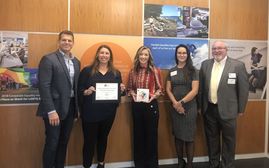
Processing Your Payment
Please do not leave this page until complete. This can take a few moments.
Maine looks beyond the numbers in search of a fair employment playing field
 Photo / Tim Greenway
Deb Breiting, left, and Liz Greason, cofounders of Maine Intercultural Communication Consulting.
Photo / Tim Greenway
Deb Breiting, left, and Liz Greason, cofounders of Maine Intercultural Communication Consulting.
Maine’s focus on diversity in hiring may have been energized by this year’s national reckoning on race, as a variety of businesses and organizations in the state pledged to make it a priority, but it began with something more prosaic.
Historic unemployment among white workers the past several years meant jobs were going unfilled, and, so, attention turned to Maine’s people of color, whose unemployment numbers stubbornly remained in double digits.
“Up until this crisis moment, I think there were good intentions, but people didn’t really know they didn’t know,” says Deb Breiting, cofounder of Maine Intercultural Communication Consultants. Employers’ attitude was often, “We want to hire people as long as they have the skills to fit into our company culture.”
The “right person” usually means the white person, according to “The State of Working Maine 2020,” published in November by the Maine Center for Economic Policy. The report found that people of color in Maine — Black, Latinx, Wabanaki, immigrants — are less likely to be hired than white people with the same education and skills.
For hiring inequities to change, employers have to change the “company culture fit” mindset, those in the hiring industry say.
Kimberly Bowen, vice president of talent management at insurance company Unum, says it goes beyond trying to hit a diversity goal. The Tennessee-based insurance company, which employs 2,800 in Maine, was named one of the nation’s “Best Employers for Diversity” by Forbes in February.
“If you’re just focused on the number, you probably aren’t going to get there, and you won’t keep whatever you find,” Bowen says. “If you haven’t created that environment, anything you do around increasing diversity will fail.”
Breiting already sees it happening.
“With the way our conversations have shifted, there’s been much more attention on the fact that cultural differences matter,” she says. “They’re saying, ‘We need to shift our systems and figure this out.’”
Racism’s high cost
Hiring people of color equitably would mean $450 million a year more in income for Mainers of color, according to the Maine Center for Economic Policy report. It would add $519 million to the state’s economy and support creation of 4,000 jobs.
The ripple effects of low wages and underemployment mean less access to healthy food, health care and adequate housing for Mainers of color.
The inequities come from systemic barriers created at the federal, state and local level that have given white Mainers an advantage “while making it harder for indigenous communities, Black families, and other Mainers of color to thrive,” the report says.
While Maine has a 95.5% white population, that doesn’t mean racism isn’t a problem.
James Myall, the Maine Center for Economic Policy analyst who wrote the report, says one of the goals was to make that clear.
“It’s sometimes easy for people to assume that racial discrimination and disparities is something that happens elsewhere,” he says. “So, it was really important for us to make that case that this is very real and present in Maine as well.”
Maine Center for Economic Policy works with legislators, and Myall says that there will likely be bills in this year’s legislative session that address some of the policy issues that support systemic racism.
‘We all lose out’
Diversity challenges in workplaces go much deeper than policy, but often coming from a foundation of bias.
Breiting and Liz Greason founded Maine Intercultural Communications Consultants five years ago after seeing how difficult it was for the English Second Language learners they worked with in Portland Adult Education to get hired.
Breiting says employers would often put someone who isn’t a native English-speaker, or is from a different culture, in an entry-level position because they couldn’t figure out where the person would fit in. After that, the employer “struggled to know how to move employees along the career path.”
Amanda Manning, a consultant with Maine Intercultural, says she knows from personal experience that not being treated as a valuable employee can lead to the employee questioning their self-worth. In many cases, the person leaves the company.
“We all lose out,” she says, when inclusion isn’t seen as an opportunity for a business.
Bowen says inclusion at Unum is seen as a key to success.
“You need to create an inclusive environment, and diversity will come,” she says. “It’s that diversity of thought, cultural differences that give people a different world view or perspective, that you want to tap into because that’s where creativity or innovation can live.”
In the corporate world, it’s not uncommon for a meeting about solutions for a group to not include a member of the group in the discussion, Bowen says. In those cases, “The solution that’s being put together really is going to fall flat.”
Creating a connection
Breiting and Greason say the solution is about educating, not shaming.
“We want to move people along their journey,” Greason says. “We really try to push back against that binary of, ‘You get it or you don’t, you’re woke or you’re not.’”
Their training isn’t a rigid framework, but is built around the client.
Breiting says building on what a client already knows makes it less overwhelming.
“People make sense of the world in the only way they know how, in terms of their own experiences,” she says. It’s hard for someone to make sense of differences they don’t have experience with. She says the starting point is to create a connection.
“It gets at the core,” Greason says. “Being effective requires meeting people where they’re at.”
An ongoing process
At Unum employees have for the past few years organized resource groups as a safe place to talk about issues. Unum’s Office of Inclusion and Diversity was created in 2018, spurred by the groups, Bowen says.

Unum has several programs to make sure the idea of diversity works in reality. The most recent is a multicultural leadership program. The nine-month course gives employees of color a track to move their career forward.
The company trains managers to be inclusive, and a catalyst program addresses specific issues. A reverse mentoring program pairs managers with diverse employees.
Bowen says having employees who feel heard and valued is an obvious benefit.
“Diverse teams have been proven to perform better,” Bowen says. “So, you are doing yourself, your organization and your customers a disservice if you’re not looking at your organization through that lens.”
Breiting says she sees employers more often recognizing the importance of cultural differences in their workplace.
Greason adds that companies are also learning, “It costs more to constantly be hiring and training than it does to retain a good knowledgeable solid workforce.”
The team at Maine Intercultural knows that turning around the grim numbers in the Maine Center for Economic Policy report is a long process, but every success counts.
Manning says sometimes in a training session, “maybe they’re there begrudgingly, but you can see the ‘ah ha moment,’ that something has changed, and if we have done nothing else, we’ve disrupted their thinking, and disrupted their natural behaviors, which in turn can help them start to question their own internal bias. That’s where you need to start.”















0 Comments